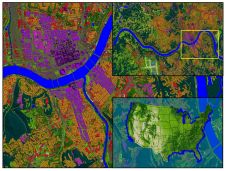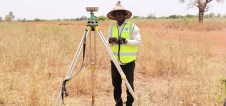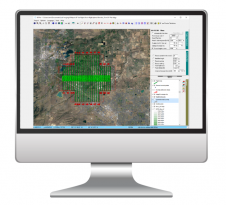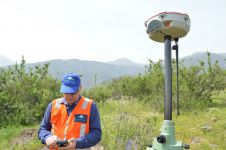NSDI in Cambodia
Administrative and Technical Challenges in Developing Countries
Spatial information is essential for sustainable development. In developing countries land management is often hindered by the absence of national spatial-information policy, guidelines for metadata management and co-ordination of spatial data. The author describes the situation in Cambodia.
规划和土地管理需要按压hensive national spatial-data infrastructure (NSDI), including a transparent land-information system (LIS). Confidence in information is assured only if there are national standards for data collection and metadata. In Cambodia national policies or standards for application, production and management of primary and secondary spatial information are not formulated. There is in place no transparent national LIS connected to a metadata system. In the absence of a national strategy there is also no single repository for nationally significant spatial information. Thus each new project, every NGO or any major development project has to acquire data from multiple sources, negotiate permissions and manipulate data in order to undertake any GIS-based planning. No national strategy exists for updating or common investment (shared procurement) of spatial information, and a common database format for the storage and dissemination of national base themes of spatial information has not been set up.
In Place Today
SDI and LIS in Cambodia was initiated by the Ministry of Land Management, Urban Planning and Construction and carried forward by the Council for Land Policy. In two provinces and three districts pilot LIS projects have been implemented. What is in place today? Little provincial and district data has been registered. Most Cambodian Ministries maintain public websites with some spatial-data content, but access to LIS content is restricted to government staff only; LIS and land-valuation information are not provided online. The National Institute for Development Assistance (NIDA) implements an eGovernment project. A pilot project for real-estate information has also been implemented in the Municipality of Phnom Penh that is not geographically based and duplicates the land-registration programme. Further spatial-data collection will cover state land demarcation, mapping and cadastral valuation, and land distribution for socio-economic development of rural areas based on a social land-reform initiative to overcome rural poverty.
Duplicated Data
地籍地图、航空摄影和土地使用ps are frequently used by ministries and provincial administrations involved in planning and managing large-scale development activities. Other forms of spatial information are used but only moderately maintained by ministries across many portfolios, including Public Works and Transport, Planning, Environment, Water Resources, Agriculture, and Forestry and Fisheries. Nationwide, digital aerial images of 10cm accuracy and land-cover interpretation have been available since 2001 to serve systematic land registration by the Ministry of Land for land-parcel identification and cadastral titling. However, the imagery widely used by ministries, donor agencies and NGOs are primarily hardcopies. Over the last decade many international agencies have been donating and managing aerial photos and satellite imagery in immense duplication. Only some of this data is maintained and managed in the Department of Geography (DoG), belonging to the Ministry of Land Management and Land Administration. International organisations and their national collaborative partner do not acknowledge the SDI responsibility of DoG. What is more, indefinite national policy measures for SDI lead to mismanagement. Most ministries are involved in spatial-data production and storage, providing individual, predominantly foreign metadata frameworks. These databases are not harmonised or mainstreamed according to a national geo-data gazetteer or the DoG GIS meta-database. Also, separate spatial data is used for extensive, commune-based environmental mapping and urban-planning measures at different scales. So much important national spatial information has been established but for administrative and political reasons remains inaccessible.
Neighbours
In Thailand, Malaysia and India, national SDI policy and the development situation differs from Cambodia. Vietnam has recently announced the establishment of a digital LIS, supported by a larger World Bank project. Only in Laos and Bangladesh can the situation be compared to Cambodia; these two countries may even be struggling at a lower level of technical implementation. The Geospatial Industry Survey 2005 estimates regional growth of SDI technology and application of 200% in south-east Asia within the next four years. The most sophisticated digital cadastres and land-information systems or national SDI policies have been established in Singapore and Hong Kong.
Concluding Remarks
Vision, strategy and detailed guidelines for NSDI in Cambodia are essential to improve access for users across government, donor and support agencies, private sector and community. Unfortunately, low salaries do not allow government staff to fulfil their job requirements and responsibilities effectively. To provide a framework for spatial-data producers, administrators, end users, decision-makers and politicians, the focus should be on institutional arrangements, setting of roles and responsibilities, and improving communication between users, data custodians and administrators. Furthermore, effective land management and land administration requires comprehensive, hierarchically structured land-information databases to be disseminated to provincial and district offices.
Acknowledgements
Thanks are due to the Cambodian Ministry of Land Management, Urban Planning and Construction, FINMAP, German Technical Co-operation Agencies and CIM, staff of the Cambodian LMAP-Project, and international advisors.
进一步的阅读
- Cambodian Council for Land Policy, 2001, Statement of Royal Cambodian Government on Land Policy, Phnom Penh.
- Dale, P., McLaughlin, J., 1999. Land Administration. Oxford University Press.
- GSDI, 2004, Designing Spatial Data Infrastructures: The SDI Cookbook, Version 2.0.
- Mabbit, R., 2004, National Spatial Development Planning Framework: Discussion Paper. Phnom Penh, European Union and HTSPE Limited: 36.
- Sotha, I.; C.; Feldkötter 2002. Management and Exchange of Geographic Information in Cambodia. Second Workshop, 13th-14th June 2002, Phnom Penh, Ministry of Land Management, Urban Planning and Construction.
Make your inbox more interesting.Add some geo.
Keep abreast of news, developments and technological advancement in the geomatics industry.
Sign up for free
























